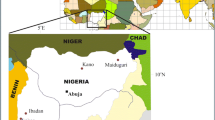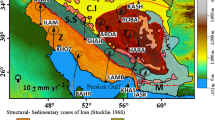Abstract
Ouarsenis mountain range located in the NW of Algeria is affected by numerous slope instabilities: (i) rock falls, related to Jurassic limestone formation and (ii) landslides initiated on moderate slopes angles ranging from 11 to 22 %, which can be related to very sensible lithology (colluviums and turbidity). These slopes show an important fluid circulation activity. This circulation is ensured by a complex karstic system embedded within the limestone mountains in high altitude (>900 m). The rose diagrams establishing of faults lineation, landslides, and elongate slope axis show a strong coincidence between the tectonic fractures and the rupture axis (RA) of the landslides (N10°, N40°, N120°, N140°). The orientations of elongate slope axis coincide mainly with the directions ~N30° and ~N160. The north slopes are affected by a high number of identified landslides because these mountain sides correspond to wetland areas. The topographic and border conditions can highly control the geometry of the landslides: the type of slope and the spread in length of the destabilized materials are strongly related. This is confirmed by the possible linear fit which links the mobility index to the maximum length of the landslides, either with fluid flow or situated in the front of tectonics overlap; these two types of landslides are characterized by low coefficients of friction 0.23 and 0.24, respectively. The landslides situated above the geomorphologic knickpoint are represented by a higher friction coefficient (0.25), as well as landslides initiated in zones without seepage water (0.29): these different apparent friction values can explained the spread in length variability of the debris. Moreover, the high landslide zone is located near a seismic area which can be related to an active deformation process associated to seismogenic faults (e.g., the earthquake which occurred in the Chlef area in October 1980).












Similar content being viewed by others
References
Adushkin VV (2000) Explosive initiation of creative processes in nature. Combust Explosion Shock Waves 36(6):695–703
Atrops F, Benest M, Almeras Y, Benosman B (1991) Découverte et dynamique d’une transgression au Callovien sur le socle tardi-hercynien dans le domaine sud-tellien (Ouarsenis, Algérie). C R Acad Sci Paris 313(13):1555–1562
Benaouali-Mebarek N, Frizon de Lamotte D, Roca E, Bracène R, Sassi W, Faure J-L, Roure F (2006) Post-Cretaceous kinematics of the Atlas and Tell systems in Central Algeria: early foreland folding and subduction-related deformation. C R Geosci 338:115–125
Benhamou M (1996) Evolution tectono-eustatique d’un bassin de la Téthys maghrébine: l’Ouarsenis (Algérie) pendant le Jurassique inférieur et moyen. Thèse de Doctorat ès Sci., Université d’Oran, 434p
Benhamou M, Elmi S, Alméras Y (2000) Age et contexte dynamique des calcaires à brachiopodes téthysiens (Zeilleriidés multiplissés) du Grand Pic de l’Ouarsenis (Tell algérien). C R Acad Sci Paris 331:717–723
Blès J-L (1971) Étude tectonique et microtectonique d’un massif autochtone tellien et de sa couverture de nappes: (le massif de Blida, Algérie du Nord). Bull Soc Géol France 13(5–6):498–511
Bouillin J-P, Durand Delga M, Gélard J-P, Leikine M, Raoult JF, Raymond D, Tefiani M, Vila J-M (1970) Définition d’un flysch massylien et d’un flysch maurétanien au sein des flyschs allochtones de l’Algérie. C R Acad Sci Paris t. 270:2249–2252
Calembert L (1952) Etude géologique du Massif culminant de l’Ouarsenis. Bull Serv Carte Géol Algérie 2(23):184p
Carrara A, Cardinali M, Detti R, Guzzetti F, Pasqui V, Reichenbach P (1991) GIS techniques and statistical models in evaluating landslide hazard. Earth Surf Process Landf 16:427–445
Carrara A, Crosta G, Frattini P (2003) Geomorphological and historical data in assessing landslide hazard. Earth Surf Process Landf 28:1125–1142
Chigira M, Yagi H (2006) Geological and geomorphological characteristics of landslides triggered by the 2004 Mid Niigata prefecture earthquake in Japan. Eng Geol 82:202–221
Corominas J (1996) The angle of reach as a mobility index for small and large landslides. Can Geotech J 33:260–271
Cruden DM, Varnes DJ (1996) Landslide types and processes. In: Turner AK, Schuster RL (eds) Landslides: investigation and mitigation (Transportation Research Board Special Report No. 247). National Academy Press, Washington, pp 36–75
Dade WB, Huppert HE (1998) Long-run out rockfalls. Geology 26:803–806
Dalloni M (1936) Matériaux pour l’étude géologique du massif de l’Ouarsenis. Bull Serv Géol Algérie 2(13):41p
DurandDelga M (1969) Mise au point sur la structure du Nord-Est de la Berberie. Bull Serv Carte Géol Algérie 39:89–131
Elmi S, Alméras Y, Benhamou M, Mekahli L, Marok A (2003) Biostratigraphie des brachiopodes et âge carixien (Pliensbachien inférieur) des calcaires à grands bivalves en Algérie occidentale. Geobios 36(6):695–706
Farès Khodja F (1968) Contribution à l’étude stratigraphique et micropaléontologique du jurassique du Tell algérien (massif culminant de l’Ouarsenis, Oued Fodda et les massifs de la plaine du Chélif-Babor). Thèse 3ème cycle, Faculté des Sciences de Paris, 166p
Finlay PJ, Mostyn GR, Fell R (1999) Landslide risk assessment: prediction of travel distance. Can Geotech J 36:556–562
Fleury P, Plagnes V, Bakalowicz M (2007) Modelling of the functioning of karst aquifers with a reservoir model: application to Fontaine de Vaucluse (South of France). J Hydrol 345(1):38–49
Glangeaud L (1951) Interprétation tectonophysique des caractères structuraux et paléogéographiques de la Méditerranée occidentale. Bull Soc Geol Fr 6(1):735–762
Goldscheider N (2005) Fold structure and underground drainage pattern in the alpine karst system Hochifen-Gottesacker. Eclogae Geol Helv 98(1):1–17
Guthrie RH, Evans SG (2004) Analysis of landslide frequencies and characteristics in a natural system, coastal British Columbia. Earth Surf Process Landf 29:1321–1339
Hattanji T, Moriwaki H (2009) Morphometric analysis of relic landslides using detailed landslide distribution maps: implications for forecasting travel distance of future landslides. Geomorphology 103(3):447–454
Hsü KJ (1975) Catastrophic debris streams (Sturzstroms) generated by rockfalls. Geol Soc Am Bull 86:129–140
Hunter G, Fell R (2003) Travel distance angle for “rapid” landslides in constructed and natural soil slopes. Can Geotech J 40(6):1123–1141
Kireche O (1993). Evolution géodynamique de la marge tellienne des Maghrébides d’après l’étude du domaine parautochtone schistosé (massifs du Chélif, d’Oranie, Bou Maâd, des Babors et des Bibans). Thèse de Doctorat, Université d’Alger, 316p
Lebuis JR, Robert JM, Rissman P (1983) Regional mapping of landslide hazard in Quebec. Proceedings of the International Symposium on Slopes on Soft Clays, Linkoping, Swedish Geotechnical Institute. Report 17:205–262
Lucas A, Mangeney A (2007) Mobility and topographic effects for large Valles Marineris landslides on Mars. Geophys Res Lett 34, L10201
Lucas A, Mangeney A, Bouchut F, Bristeau MO, Mège D (2007) Benchmark exercises for granular flows. The 2007 International Forum on Landslide Disaster Management, Ho and Li, 2:967–986
Lucas A, Mangeney A, Mège D, Kelfoun K (2008) New methodology for initial volume estimation of Martian landslides from DTM and imagery. Workshop on Martian Gullies: Theory and Tests, Houston, TX., 8023
Lucchitta BK (1987) Valles Marineris, Mars-Wet debris flows and ground ice. Icarus 72:411–429
Mangeney A, Bouchut F, Thomas N, Vilotte J-P, Bristeau M-O (2007) Numerical modeling of self-channeling granular flows and of their level channel deposits. J Geophys Res 112, F02017
Mangeney-Castelnau A, Bouchut F, Vilotte JP, Lajeunesse E, Aubertin E, Pirulli M (2005) On the use of Saint Venant equations to simulate the spreading of a granular mass. J Geophys Res 110, B09103
Maquaire O, Weber C, Thiery Y, Puisant A, Malet JP, Wania A (2004) Current practices and assessment tools of landslide vulnerability in mountainous basins. Identification of exposed elements with a semi-automatic procedure. Proceedings 9th International Symposium on Landslides, Leiden, Balkema: 171–176
Martha TR, Kerle N, Jetten V, van Westen CJ, Kumar KV (2010) Characterising spectral, spatial and morphometric properties of landslides for semi-automatic detection using object-oriented methods. Geomorphology 116(1):24–36
Mattauer M (1958) Etude géologique de l’Ouarsenis oriental (Algérie). Bull Serv Géol Algérie, Monogr Régionale 17:534p
Meghraoui M, Pondrelli S (2013) Active faulting and transpression tectonics along the plate boundary in North Africa. Ann Geophys 55(5), doi:10.4401/ag.4970
Okura Y, Kitahara H, Kawanami A, Kurokawa U (2003) Topography and volume effects on travel distance of surface failure. Eng Geol 67:243–254
Polvèche J (1960) Contribution à l’étude géologique de l’Ouarsenis oranais. Bulletin des Services de la Carte géologique de l’Algérie, Bulletin 24(I,II), 577p
Raoult JF (1974) Géologie du centre de la chaîne numidique (Nord du Constantinois, Algérie). Mém.Soc. géol. France, N.S., t. III, n° 121, 164 p
Scheidegger AE (1973) On the prediction of reach and velocity of catastrophic landslides. Rock Mech 5:231–236
Soltner D (1992) Les bases de la production végétale le sol, le climat, la plante Tome II, Le climat, 6ème édition. Collection sciences et techniques agricoles. 320p
Tchoumatchenco P, Nikolov T, Kozhukharov D, Benev B, Gochev P, Katzkov N, Khrischev K, Moev M, Nicolov Z, Slavov I, Tzankov T, Zidarov N (1995) Le Crétacé inférieur dans le massif de l’Ouarsenis et les Monts de Tiaret (Algérie du Nord). Geol Balc 25(2):27–59
Thiery Y (2007) Susceptibilité du bassin de Barcelonnette (Alpes du Sud, France) aux ‘mouvements de versant’: cartographie morphodynamique, analyse spatiale et modélisation probabiliste, Thèse de Doctorat, université de Basse Normandie, Caen, 445p
Thiery Y, Malet J-P, Maquaire O (2004) Observation on the activity of the Bois Noir landslide. Internal Report, EC-FP5 Alarm Project, Brussels. 10p
Thiery Y, Malet J-P, Sterlacchini S, Puissant A, Maquaire O (2007) Landslide susceptibility assessment by bivariate methods at large scales: application to a complex mountainous environment. Geomorphology 92:38–59
Wildi W (1983) La chaîne tello-rifaine (Algérie, Maroc, Tunisie): structure, stratigraphie et évolution du Trias au Miocène. Rev Géogr Phys Géol Dynam Paris 3:201–299
Acknowledgments
The authors are indebted to the anonymous reviewer for the constructive remarks which helped improve the final version of the manuscript. The authors wish to thank the local village authorities of Bordj Bou Naama for ease of access in the field as well as the availability under our all documents necessary for the preparation of this work. One of the authors would like to thank the regional project Mistrals “ENVI-MED.”
Author information
Authors and Affiliations
Corresponding author
Rights and permissions
About this article
Cite this article
Mansour, Z., Miloud, B., Donzé, F. et al. Morphometric analysis of landslides in the Ouarsenis area (west Algeria): implications for establishing a relationship between tectonic, geomorphologic, and hydraulic indexes. Arab J Geosci 8, 6465–6482 (2015). https://doi.org/10.1007/s12517-014-1711-5
Received:
Accepted:
Published:
Issue Date:
DOI: https://doi.org/10.1007/s12517-014-1711-5




